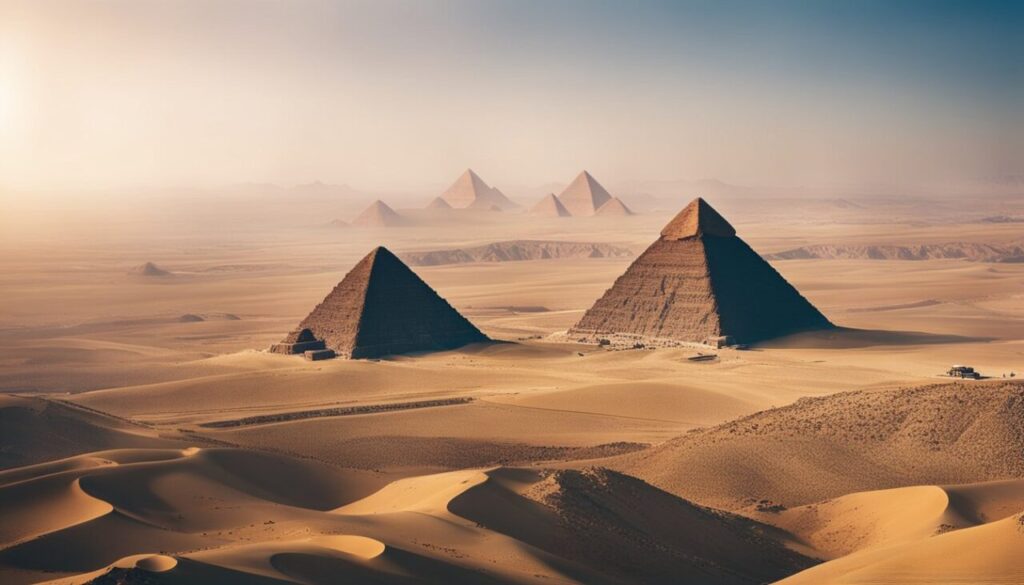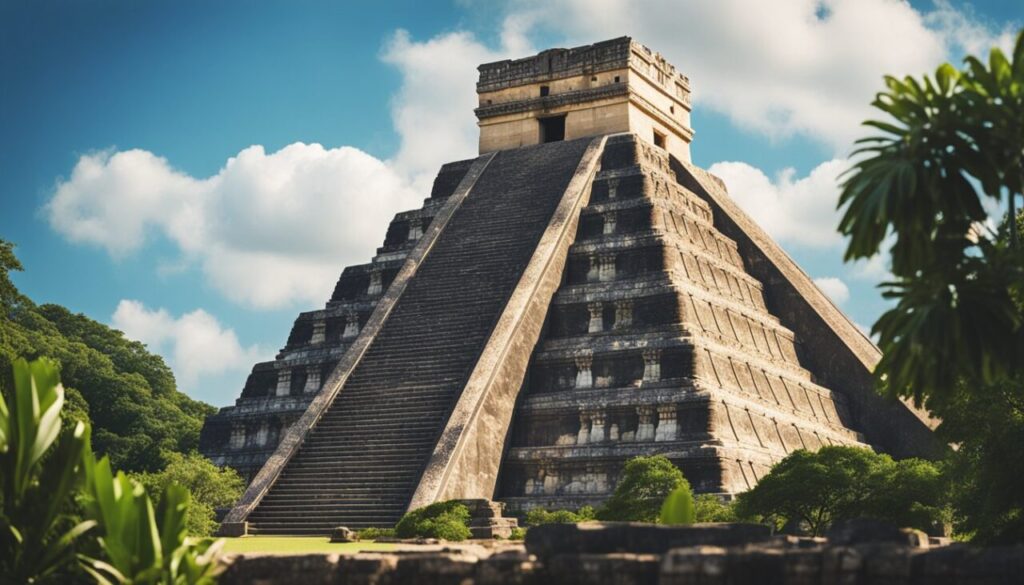
Pyramids are certainly one of the most fascinating buildings on Earth. They are amazing in every possible way.
These ancient structures have been built by civilizations across the world, from Egypt to Mexico.
But just how many pyramids are there in the world? The answer may surprise you.
The first thing that comes to mind when thinking about pyramids is probably Egypt. And, we’ve written in detail about Egyptian Pyramids in this article: “How Many Pyramids Are In Egypt: A Comprehensive Guide.”
However, pyramids can be found in other countries as well, and there are many of them.
So, let’s find exactly how many.
Interesting fact: The largest pyramid in the world is the Great Pyramid of Cholula, located in Mexico. It measures 450 meters on each side and stands 66 meters tall. However, it is not as well-known as the Pyramids of Giza, which are often considered the most impressive pyramids in the world.
Number of Pyramids

Determining the exact number of pyramids in the world is a difficult task, as new discoveries are constantly being made.
However, based on current knowledge, there are more than 500 pyramids worldwide.
To provide a better understanding of the number of pyramids in different countries, the table below shows the number of pyramids in Egypt, Sudan, Mexico, and other countries.
| Country | Number of Pyramids |
| Egypt | 138 |
| Sudan | 255 |
| Mexico | 100+ |
| China | 38 |
| Peru | 30+ |
| Others | 10+ |
Recommendation: As fascination with the pyramids grows, so does curiosity about the various structures found around the globe. From the famous Great Pyramid of Giza to lesser-known pyramid sites, travelers are eager to explore these ancient wonders. For those embarking on a journey to visit these iconic landmarks, Custom Luggage Tags are a great way to personalize their travel gear. Featuring unique designs like pyramids, historical motifs, or custom engravings, these tags not only make luggage easily identifiable but also serve as a reminder of the amazing history they’re about to experience.
Ok, so now let’s take a closer look at all of those pyramid complexes.
Ancient Egyptian Pyramids

As we’ve written in our article about Pyramids, there are approximately 118 pyramids in Egypt.
Here is the list of some of them:
| Pyramid Name | Pharaoh | Site |
| Great Pyramid of Giza | Khufu (Cheops) | Giza |
| Pyramid of Khafre | Khafre | Giza |
| Pyramid of Menkaure | Menkaure | Giza |
| Step Pyramid of Djoser | Djoser | Saqqara |
| Bent Pyramid | Sneferu | Dahshur |
| Red Pyramid | Sneferu | Dahshur |
| Pyramid of Meidum | Huni/Sneferu | Meidum |
| Pyramid of Unas | Unas | Saqqara |
| Pyramid of Teti | Teti | Saqqara |
| Pyramid of Pepi II | Pepi II | Saqqara |
| Pyramid of Userkaf | Userkaf | Saqqara |
| Pyramid of Sahure | Sahure | Abusir |
| Pyramid of Neferirkare | Neferirkare | Abusir |
| Pyramid of Niuserre | Niuserre | Abusir |
| Pyramid of Neferhetepes | Neferhetepes | Saqqara |
| Pyramid of Djedkare | Djedkare | Saqqara |
| Pyramid of Menkauhor | Menkauhor | Saqqara |
| Pyramid of Merenre | Merenre | Saqqara |
| Pyramid of Amenemhat I | Amenemhat I | Lisht |
| Pyramid of Senusret I | Senusret I | Lisht |
| Pyramid of Amenemhat II | Amenemhat II | Dahshur |
| Pyramid of Senusret II | Senusret II | Lahun |
| Pyramid of Senusret III | Senusret III | Dahshur |
| Pyramid of Amenemhat III | Amenemhat III | Dahshur |
| Pyramid of Amenemhat IV | Amenemhat IV | Mazghuna |
| Pyramid of Sobekneferu | Sobekneferu | Mazghuna |
| Pyramid of Khendjer | Khendjer | Saqqara |
Interesting, huh?
Let’s explore more about those famous buildings.
The Giza Pyramid Complex

The most famous Egyptian pyramids are those found at Giza, on the outskirts of Cairo. The Giza Pyramid Complex consists of three pyramids: the Great Pyramid of Khufu, the Pyramid of Khafre, and the Pyramid of Menkaure.
The Great Pyramid of Khufu is the largest and the oldest of the Seven Wonders of the Ancient World still in existence. It was built over a period of 20 years and is estimated to have used around 2.3 million stone blocks, each weighing between 2 and 80 tons.
The Pyramid of Khafre is the second-tallest pyramid at Giza and contains the tomb of Pharaoh Khafre. It is believed to have been built using a slightly steeper angle than the Great Pyramid of Khufu, giving it the appearance of being taller.
The Pyramid of Menkaure is the smallest of the three pyramids and is believed to have been built for Pharaoh Menkaure.
Interesting fact: The Great Pyramid of Khufu is so large that it was originally covered in over 100,000 polished limestone blocks, each weighing between 5 and 15 tons.
Lesser-Known Pyramids in Egypt

In addition to the pyramids at Giza, there are many other pyramids in Egypt, some of which are lesser-known but still impressive.
For example, the Step Pyramid of Djoser, located in Saqqara, is considered to be the world’s oldest major stone structure. It was built during the Third Dynasty and is believed to have been designed by the architect Imhotep.
Another impressive pyramid is the Pyramid of Amenemhat III, located in Dahshur. This pyramid is unique in that it has two entrances and two burial chambers, suggesting that it was built for two pharaohs.
The Pyramid of Senusret III, also located in Dahshur, is another interesting pyramid. It was built using a unique design that included a sloping entrance passage and a complex system of corridors and chambers.
Interesting fact: The Pyramid of Amenemhat III is believed to have been built using mud bricks, which were covered in limestone to give the appearance of a stone pyramid.
Pyramids in the Americas

Mesoamerican Pyramids
Mesoamerica is a region that stretches from central Mexico to parts of Central America. The Mesoamerican people built pyramids from around 1000 B.C. up until the time of the Spanish conquest in the early 16th century.
The most famous Mesoamerican pyramids are found in Mexico, particularly in the ancient cities of Teotihuacan, Cholula, and Tenochtitlan.
Teotihuacan, located near Mexico City, is home to the Pyramid of the Sun and the Pyramid of the Moon. The Pyramid of the Sun is the largest pyramid in Teotihuacan and the third-largest pyramid in the world.
It measures approximately 215 meters (705 feet) in width and 65 meters (213 feet) in height.
The Pyramid of the Moon, located at the northern end of the Avenue of the Dead, is slightly smaller than the Pyramid of the Sun but still an impressive structure.
Cholula, located in the state of Puebla, is home to the Great Pyramid of Cholula, which is the largest pyramid in the world by volume.
Although it is not as tall as some of the other pyramids in the region, it covers an area of approximately 4 hectares (10 acres) and has a base diameter of 450 meters (1,476 feet).
Interesting fact: The Maya civilization, which flourished in southern Mexico and Central America from about 2000 B.C. until the Spanish conquest, built over 4,000 structures, including pyramids.
South American Pyramids

South America is home to some of the most impressive pyramids in the world, particularly in Peru and Bolivia.
Peru is home to several pyramid complexes, including the Huaca del Sol and Huaca de la Luna, located in the city of Trujillo.
These pyramids were built by the Moche civilization between 100 and 800 AD and are thought to have been used for religious ceremonies.
Interesting fact: The largest adobe structure in the world, the Huaca del Sol, is located in Peru and is estimated to have been built by over 100,000 workers over the course of several decades.
Pyramids in Other Regions

Sudanese Pyramids
While Egypt is undoubtedly the most famous location for pyramids, there are other regions where these structures can be found. And in really large numbers.
One such region is Sudan, where there are over 200 pyramids. These pyramids were built by the Kingdom of Kush, which was located in what is now Sudan and southern Egypt.
The pyramids were constructed between the 8th century BC and the 4th century AD.
Unlike the pyramids in Egypt, the Sudanese pyramids are smaller and steeper. They were also built for different purposes.
While the Egyptian pyramids were (presumably) used as tombs for pharaohs, the Sudanese pyramids were used as tombs for kings and queens.
European Pyramid Structures

While pyramids are typically associated with ancient Egypt and Sudan, there are also pyramid structures in Europe.
One such structure is the Bosnian Pyramid of the Sun, which is located in Visoko, Bosnia and Herzegovina.
This pyramid is controversial, with some experts claiming that it is a natural formation, while others argue that it was built by an ancient civilization.
Another pyramid structure in Europe is the Pyramid of Cestius. It was built around 18–12 BC as a tomb for Gaius Cestius.
Then we also have the Pyramid of Hellinikon in Peloponnese, Greece. Its purpose is still debated.
Some theories suggest it may have been a watchtower or a monument, dating back to around the 4th century BC.
Interesting fact: The Bosnian Pyramid of the Sun is taller than the Great Pyramid of Giza, standing at around 220 meters tall. However, its authenticity as a pyramid is still a matter of debate among experts.
Modern Replicas and Inspired Structures

The fascination with the ancient pyramids of Egypt has led to the construction of modern replicas and inspired structures around the world.
These structures range from hotels and casinos to museums and monuments. Some of the most notable modern pyramids include:
- The Luxor Las Vegas pyramid: This casino and hotel complex located on the Las Vegas strip is a prime example of postmodernist architecture from the 90s. It is complete with a Sphinx statue and a bright light beam that shines from its tip at night.
- The Pyramid Arena in Memphis, Tennessee: This monument is ranked as the sixth largest pyramid in the world, standing at 321 feet in height. It was built as a sports and entertainment venue and has hosted events such as basketball games and concerts.
- The Louvre Pyramid in Paris, France: This glass and metal pyramid serves as the entrance to the famous Louvre Museum. It was designed by the Chinese-American architect I.M. Pei and has become an iconic symbol of the museum.
- The Transamerica Pyramid in San Francisco, California: This skyscraper is not a true pyramid in shape, but its tapering design and pointed top give it a pyramid-like appearance. It was completed in 1972 and was the tallest building in San Francisco until 2018.
Conclusion

In conclusion, there are more than 500 pyramids worldwide, with the majority located in Egypt and Sudan. However, pyramids can also be found in countries such as Mexico, Peru, and some other places.
These pyramids were built by different civilizations and for different purposes, ranging from religious and ceremonial to funerary.
When categorizing the pyramids, they can be divided into three main types: step pyramids, true pyramids, and truncated pyramids.
Step pyramids, such as the Pyramid of Djoser in Egypt, were the earliest form of pyramids and consisted of a series of platforms stacked on top of each other.
True pyramids, such as the Great Pyramid of Giza, are the most recognizable and have smooth, sloping sides leading to a point at the top.
Truncated pyramids, such as the Pyramid of the Sun in Mexico, have flat tops and are shorter than true pyramids.
And so, when calculating the overall number of pyramids, it is important to note that new discoveries are constantly being made, especially in remote areas using advanced scanning technologies.
Therefore, the precise number of pyramids in each country is difficult to determine.
Nevertheless, those monumental buildings around the world stand there to remind us of ancient civilizations and their great acomplishments.
Who knows, maybe one day this modern and advanced civilization will regain the knowledge to build new pyramids.



























